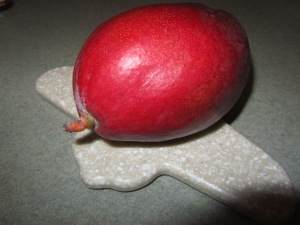There are some vegetables out there that are refreshing, tasty and exude flavors both inside and outside. You peel and chop them, toss them in your cooking and the final product smells and tastes delicious. The vegetable stands out among the rest of the ingredients. You bite into it and you feel the warmth of it.
While there are many such vegetables, the one I am talking about here is bottle gourd (aka long melon or oko squash). It is a versatile vegetable, one that has many uses in cooking. Boil, season and sprinkle some coconut or sesame powder or mustard powder. Cook in milk with some sugar and season. Toss in dal or cook in curd or green leafy vegetable or make sweet curry like stew with mixed vegetables and many more.
Growing up I watched my mother do this often. It’s interesting how it all comes back to you when you start to cook. Most of my South Indian cooking is based on what I watched my mother do. So patiently peeling this, chopping that and especially the laborious task of chopping and making pickles, plucking leaves from stalks of sorrel leaves and so much more. All that seemed so cumbersome and difficult then. But the end product always delicious. Cooking was a labor of love for my mother. But most of her recipes are etched in her brain. Now I cling to those memories of when I watched her cook, as I try to cook as close to the tastes and flavors I can remember.
Each time I cook bottle gourd I end up making three different dishes. I peel and chop the bottle gourd into 1-2in squares and toss them into samhbhar, sweet pulusu (curry like stew) or challa pulusu (yogurt based stew). I chop it into smaller pieces and cook with yellow gram (pesara pappu) or with coconut or sesame. And those nice, green skin that I peel? Well don’t throw them out yet. I wash and dry them out in paper towels and make chutney with it. Here’s how I make mine based on the recollection I have of how my mother makes it:
Ingredients:
Peel of 1 bottle gourd
1 tsp tamarind paste
a little jaggery or sugar
salt to taste
1 jalapeno (optional)
cilantro
Seasoning:
4-6 red chili
1 tsp mustard seeds
1 tsp cumin seeds
1 tsp black gram (urad dal)
pinch of turmeric
pinch of asafoetida
1-2 tbsp olive oil
Heat one table spoon oil in a pan and fry the seasoning ingredients till lightly brown. Remove from pan and set aside.
In the same pan, add more oil. Add the peeled bottle gourd skin and salt and fry in medium low flame till cooked and turns slightly brownish. Remove from pan and transfer to a blender. Add the fried whole red chilli, tamarind and jaggery. Add jalapeno and cilantro and blend with a little water to a smooth paste.
Transfer from blender to a bowl and mix the rest of the seasoning ingredients. Stays upto a week or 10 days in the refrigerator. Can be used as side with Roti or eaten with rice.








